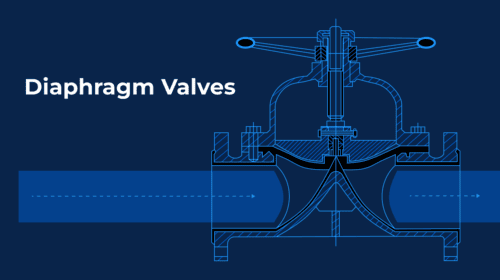Understanding Globe Valves: Functions, Types and Use Cases

In industrial applications, selecting the right valve type is crucial to ensuring efficient and reliable fluid control. Among the various valve options available, globe valves stand out for their precision and versatility. But what is a globe valve, and why is it an essential component in many pipe systems?
A globe valve is a type of control valve designed to regulate the flow of fluids through a pipeline. Its unique construction features a movable plug or disc and a stationary ring seat within a typically spherical body, allowing it to provide precise flow control. This post will guide you through the functions, types and applications of globe valves, helping you understand how they can meet the specific needs of your industrial processes.
How Do Globe Valves Work?
Globe valves are engineered to provide precise control over fluid flow, making them indispensable in a variety of industrial settings. The key to their functionality lies in their unique design, particularly the globe-shaped disc, which plays a crucial role in flow regulation.
Flow Control Mechanism
At the heart of a globe valve is the movable disc, positioned against a stationary ring seat within the valve body. When the valve is open, the disc is lifted away from the seat, allowing fluid to flow through the pipeline. The disc’s movement regulates the flow in several important ways:
- Opens completely: The disc is fully lifted, allowing maximum flow.
- Closes partially: The disc is partially lowered to reduce the flow rate.
- Closes completely: The disc fully seals against the seat to stop the flow entirely.
This ability to finely adjust the flow is one of the primary globe valve functions and makes them ideal for applications that require precise control.
Sealing Capabilities
One of the notable advantages of globe valves is their excellent sealing capability. The design enables the disc to create a tight seal against the flow, minimizing the risk of leaks. This makes globe valves particularly effective in high-pressure environments, such as chemical processing or power generation, where maintaining a secure seal is critical to system performance and safety.
Directional Flow
Globe valves are available in various configurations, including:
- Two-way globe valve design: Used to start, stop, or modulate fluid flow in one direction
- Three-way globe valve design: Enables fluid diversion between two different outputs or mixing two fluids into a single stream
These configurations expand the types of globe valve applications, making them versatile tools in industries requiring varying flow solutions.
3 Common Types of Globe Valves
Globe valves come in a few different designs, with each tailored to specific applications and operational needs. Here are the three most common types.
T-pattern Globe Valves
The T-pattern globe valve, also known as a Z-pattern, features a horizontal seat with the disc moving perpendicular to the flow. This design is the most widely used due to its versatility and effectiveness in controlling flow in general-purpose applications, such as water distribution and HVAC systems. It offers several advantages, including:
- General flow control: Ideal for applications requiring moderate throttling and flow regulation
- Ease of maintenance: The straightforward design allows for relatively simple disassembly and maintenance.
Y-pattern Globe Valves
The Y-pattern globe valve is engineered with an angled seat, forming a Y-shape when viewed in cross-section. This design significantly reduces flow resistance and pressure drop, making it more efficient in terms of fluid dynamics. It’s particularly beneficial in situations where low-pressure loss and high flow capacity are critical, such as in cooling systems and oil pipelines. Y-pattern globe valves offer the following benefits:
- Improved flow efficiency: The angled seat allows for smoother fluid movement, reducing turbulence.
- Maintenance-friendly: Easier access to internal components due to the slanted design, simplifying upkeep
Angle Globe Valves
Angle globe valves are designed with a 90-degree angle between the inlet and outlet, making them ideal for applications involving a change in the direction of flow. This design can lead to cost savings, thanks to:
- Reduced flow resistance: The design minimizes pressure drop by eliminating unnecessary turns in the piping.
- Fewer pipe joints: The angle valve reduces the need for additional fittings, saving space and reducing potential leak points.
Bonnet Connections in Globe Valves
The bonnet connection is a critical component of a globe valve, playing a significant role in the valve’s overall performance, especially in terms of maintenance and pressure handling. Here’s a look at the most common types of bonnet connections and their specific advantages:
Bolted Bonnets
Bolted bonnets are widely used in globe valves due to their durability and ease of maintenance. This design distributes the tightening force across multiple bolts, making it suitable for a variety of sizes and pressure levels. The benefits of bolted bonnets include:
- Versatility: Can handle various valve sizes and pressure conditions
- Ease of access: Ideal for applications requiring regular maintenance
Welded Bonnets
Welded bonnets are designed for high-pressure applications, creating a strong, permanent seal. However, they are more challenging to maintain because the valve must be cut open for internal access. Welded bonnets are best for:
- Long-term use: Ideal for maintenance-free, long-term operations
- High-pressure environments: Reliable in applications with significant pressure
Flanged Bonnets
Flanged bonnets offer the advantage of easy installation and removal, making them a popular choice for valves needing regular maintenance. Key advantages of flanged bonnets include:
- Quick access: The bonnet can be easily detached for inspection and repairs.
- Minimal downtime: Suitable for applications where maintenance speed is crucial
Union Ring Bonnets
Union ring bonnets feature a threaded connection that ensures secure fastening while minimizing joint movement. This design is particularly beneficial for:
- Precision: Allows for easy alignment without damaging sealing surfaces
- Small valves: Often used in smaller valves requiring accurate assembly
Pressure Seal Bonnets
Pressure seal bonnets are engineered for high-pressure scenarios, where maintaining a tight seal is essential. As the internal pressure rises, the sealing capability improves. These bonnets are ideal for:
- Leak prevention: Ensures a tighter seal in high-pressure conditions
- High-temperature environments: Effective in industries with significant pressure and temperature fluctuations
Incorporating the right bonnet connection is crucial for ensuring the reliability and longevity of a globe valve, especially in demanding industrial environments.
Common Uses and Applications of Globe Valves
IndustriesGlobe valves are utilized in a range of sectors due to their ability to manage flow under varying conditions. |
|
|
Wastewater Treatment Regulates the flow of water and chemicals in treatment processes, ensuring safe and efficient operations |
Chemical Processing Handles corrosive and hazardous materials, where maintaining control is crucial for both safety and process efficiency |
| Food Processing
Controls fluid movement in the production of beverages, dairy products and other consumables, maintaining the integrity of the final product |
Power Generation
Manages high-pressure steam and other critical fluids in energy production, contributing to stable and efficient power generation |
ApplicationsIn addition to their broad industrial use, globe valves are particularly suited for specific tasks that require careful control of fluid dynamics. |
|
|
Mixing Fluids Facilitates the precise combination of different fluids, essential in processes where consistency and accuracy are paramount |
Throttling Reduces fluid velocity or pressure at specific points within a system, helping to mitigate issues such as water hammer and manage pressure effectively |
Advantages and Disadvantages of Using Globe Valves
When selecting a globe valve for specific applications, it’s important to consider both the strengths and limitations.
Advantages include:
- Precise flow control
- Throttling capability
- High-pressure suitability
- Good sealing performance
Disadvantages include:
- Higher pressure drop
- Complexity in installation and maintenance
These factors should guide your decision-making process, ensuring that the chosen valve meets the specific demands of your system.
Globe Valve Maintenance and Troubleshooting Tips
Regular upkeep is key to keeping your globe valves in peak condition. Here are a few essential practices to follow.
- Regular inspections: Periodically check for leaks, corrosion and wear to catch issues early.
- Lubrication and cleaning: Keep components well-lubricated and clean to ensure smooth operation.
- Troubleshooting: Address common issues such as stem leakage and improper seating promptly to maintain effective performance.
Choosing the right globe valve and properly maintaining it can significantly impact your system’s efficiency and longevity. To help you make the best choices, our “Valve Sizing 101” guide offers detailed insights into selecting and sizing valves for various applications. Download it today to ensure you’re fully equipped to optimize your fluid control systems.









